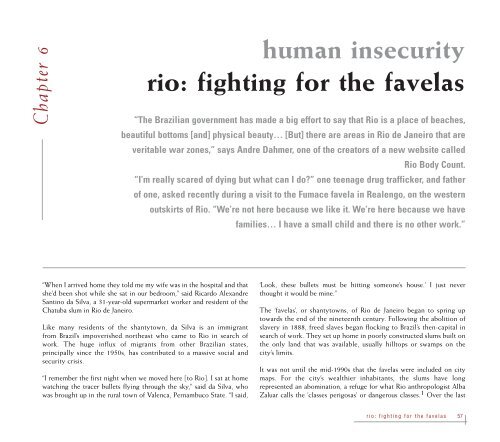Create successful ePaper yourself
Turn your PDF publications into a flip-book with our unique Google optimized e-Paper software.
Chapter 6<br />
human insecurity<br />
rio: <strong>fighting</strong> <strong>for</strong> <strong>the</strong> <strong>favelas</strong><br />
“The Brazilian government has made a big ef<strong>for</strong>t to say that <strong>Rio</strong> is a place of beaches,<br />
beautiful bottoms [and] physical beauty… [But] <strong>the</strong>re are areas in <strong>Rio</strong> de Janeiro that are<br />
veritable war zones,” says Andre Dahmer, one of <strong>the</strong> creators of a new website called<br />
<strong>Rio</strong> Body Count.<br />
“I’m really scared of dying but what can I do?” one teenage drug trafficker, and fa<strong>the</strong>r<br />
of one, asked recently during a visit to <strong>the</strong> Fumace favela in Realengo, on <strong>the</strong> western<br />
outskirts of <strong>Rio</strong>. “We’re not here because we like it. We’re here because we have<br />
families… I have a small child and <strong>the</strong>re is no o<strong>the</strong>r work.”<br />
“When I arrived home <strong>the</strong>y told me my wife was in <strong>the</strong> hospital and that<br />
she’d been shot while she sat in our bedroom,” said Ricardo Alexandre<br />
Santino da Silva, a 31-year-old supermarket worker and resident of <strong>the</strong><br />
Chatuba slum in <strong>Rio</strong> de Janeiro.<br />
Like many residents of <strong>the</strong> shantytown, da Silva is an immigrant<br />
from Brazil’s impoverished nor<strong>the</strong>ast who came to <strong>Rio</strong> in search of<br />
work. The huge influx of migrants from o<strong>the</strong>r Brazilian states,<br />
principally since <strong>the</strong> 1950s, has contributed to a massive social and<br />
security crisis.<br />
“I remember <strong>the</strong> first night when we moved here [to <strong>Rio</strong>]. I sat at home<br />
watching <strong>the</strong> tracer bullets flying through <strong>the</strong> sky,” said da Silva, who<br />
was brought up in <strong>the</strong> rural town of Valenca, Pernambuco State. “I said,<br />
‘Look, <strong>the</strong>se bullets must be hitting someone’s house.’ I just never<br />
thought it would be mine.”<br />
The ‘<strong>favelas</strong>’, or shantytowns, of <strong>Rio</strong> de Janeiro began to spring up<br />
towards <strong>the</strong> end of <strong>the</strong> nineteenth century. Following <strong>the</strong> abolition of<br />
slavery in 1888, freed slaves began flocking to Brazil’s <strong>the</strong>n-capital in<br />
search of work. They set up home in poorly constructed slums built on<br />
<strong>the</strong> only land that was available, usually hilltops or swamps on <strong>the</strong><br />
city’s limits.<br />
It was not until <strong>the</strong> mid-1990s that <strong>the</strong> <strong>favelas</strong> were included on city<br />
maps. For <strong>the</strong> city’s wealthier inhabitants, <strong>the</strong> slums have long<br />
represented an abomination, a refuge <strong>for</strong> what <strong>Rio</strong> anthropologist Alba<br />
Zaluar calls <strong>the</strong> ’classes perigosas’ or dangerous classes. 1 Over <strong>the</strong> last<br />
r i o : f i g h t i n g f o r t h e f a v e l a s 57

















